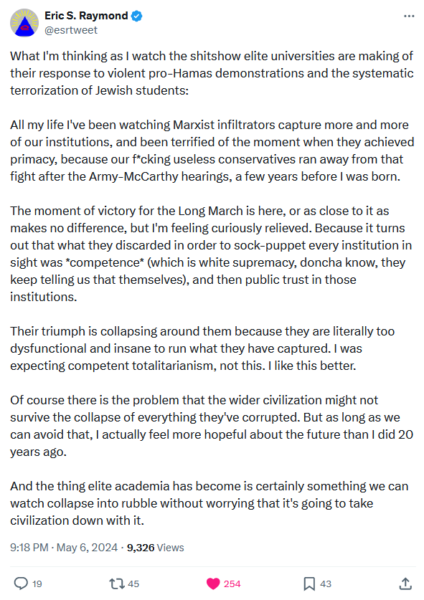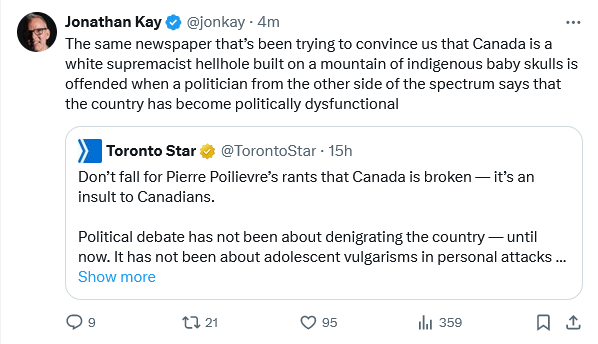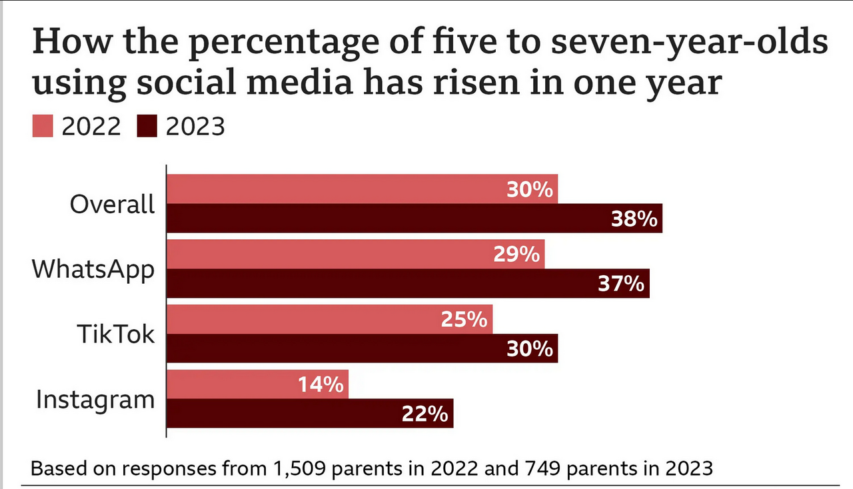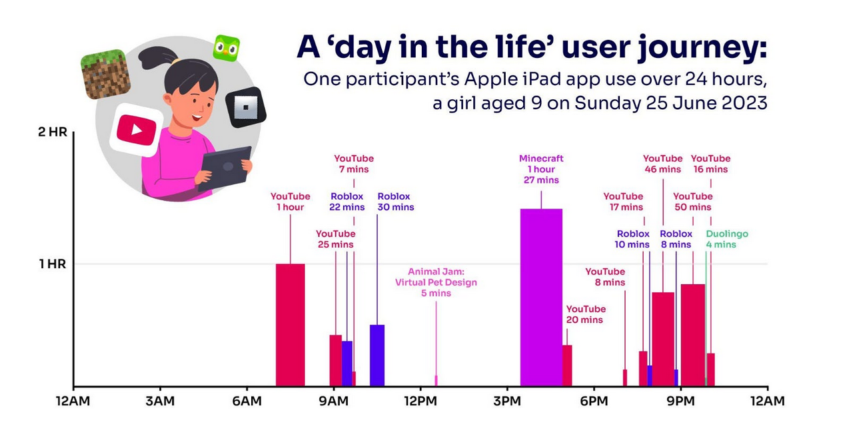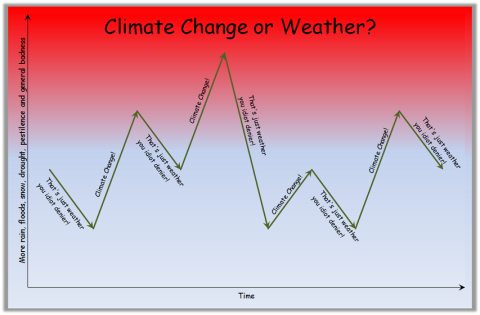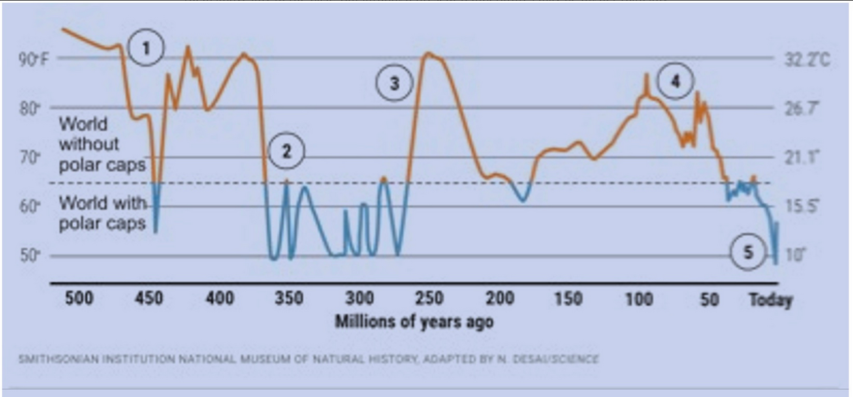As readers know, I’m deeply sympathetic to the argument that Israel has over-reached, over-bombed, and over-reacted in its near-unhinged overkill of Palestinian civilians, especially children, in the wake of 10/7’s horrors. It has been truly horrifying. I begrudge no one demonstrating passionately to protest this. But as I watch the rhetoric and tactics of many — but not all — of these students, I’m struck by how this humane concern is less prominent than the rank illiberalism and ideological extremism among many.
Preventing students from attending classes, taking exams, or even walking around their own campus freely is not a protest; it’s a crime. So is the destruction of property, and the use of physical intimidation and violence against dissenting students. The use of masks to conceal identity is reminiscent of the Klan, and antithetical to non-violent civil disobedience. It’s a way for outsiders to easily infiltrate and a way to escape responsibility for thuggishness. It’s menacing, ugly and cowardly.
It did not have to be this way. Imagine if students simply demonstrated peacefully for a cease-fire, placed the victims and hostages at the forefront of the narrative, and allowed themselves to be arrested proudly on camera and face legal consequences for their actions, as the civil rights movement did. Imagine if they were emphatically non-violent and always open to debate.
But they aren’t, because they are not the inheritors of the Christian, universalist civil rights movement but its illiberal, blood-and-soil nemesis, long curated in the Ivy League. The key group behind the protests, Students For Justice in Palestine, doesn’t mince words. It celebrated the explicitly genocidal murder of Jews on October 7:
National liberation is near — glory to our resistance, to our martyrs, and to our steadfast people! … Resistance comes in all forms — armed struggle, general strikes, and popular demonstrations. All of it is legitimate, and all of it is necessary.
The “our” is interesting. If you think these protests are only about Gaza — and not America — you’re missing the deeper context. Here’s a masked, keffiyeh-wearing spokeswoman for the UCLA protest:
Given the fact that the University of California is founded on colonialism, it’s inherently a violent institution. There needs to be an addressment of US imperialism and its ties to the UC system and how it perpetuates war and violence aboard — not only abroad, but also here, locally.
So violence is justified in response. Here’s a keffiyeh-clad spokesman at CUNY:
This revolution, which includes the mass demonstrations and encampments, are not just exclusively for students. It is for the masses. … It is for the free people of the world who are able to resist however you can — whether it be with a rock and other tools of liberation.
These are not fringe figures; they have been chosen to speak to the public. They believe in violence because there is nothing in their worldview that could prohibit it against certain “oppressor” races of people. As one of the “queer” leaders of the Columbia protest has said: “Zionists don’t deserve to live”, and “Be grateful that I’m not just going out and murdering Zionists”. He took his classes in decolonization seriously, even if he is now backtracking from their logical conclusion.
The illiberalism is deep and endemic. The civil rights movement was desperate for the press to show up; these thugs follow observers menacingly around, holding up barriers to prevent even fellow students from filming them. The civil rights movement ended physical borders between groups of human beings; these thugs create borders and police dissent. The civil rights movement asked America to live up to its ideals; the woke believe America is a source of evil in the world, and needs to be “decolonized”. “I love Osama [bin Laden]”, one pro-Palestinian demonstrator in New York City said. “I want to suck his dick”. That mix of evil and scatology is a woke trademark.
And these protests are clearly as much about the abolition of the Jewish state as they are the horror of Gaza. They are driven by the neoracist idea that “white-people-are-bad-but-black-and-brown-people-are-good”; they are about a blood-and-soil “anti-imperialism” that requires the abolition of any state not reflective of ancient indigenous populations. (The SJP refers to the US as “Turtle Island”, an allegedly indigenous name.) They are against “cultural appropriation” but prance around in keffiyehs. They glibly use the word “genocide” to trigger and re-traumatize Jews, while ignoring the genocidal goals of Hamas; and chants of “There Is Only One Solution: Intifada Revolution!” ring with echoes of Nazism.
And they will help Trump get an Electoral College landslide, just as the new left handily elected Nixon in 1968 and 1972.
It tells you something when even Al Sharpton is rattled by these violent fanatics. “How do the Democrats — how do all of us on that side — say January 6th was wrong if you can have the same pictures going on on college campuses?” he asked on MSNBC. It feels like 2020 again. Replacing Old Glory with the Palestinian flag or defacing a statue of George Washington (see above), is not how you win over the country. But the more you know about these fanatics the more you realize they don’t want to win over the country; they want to destroy it as mindlessly as the pro-Trump fringe. And they’d welcome the even deeper polarization he’d bring.

